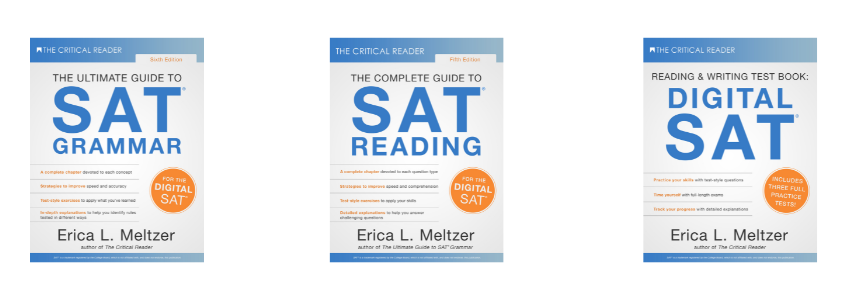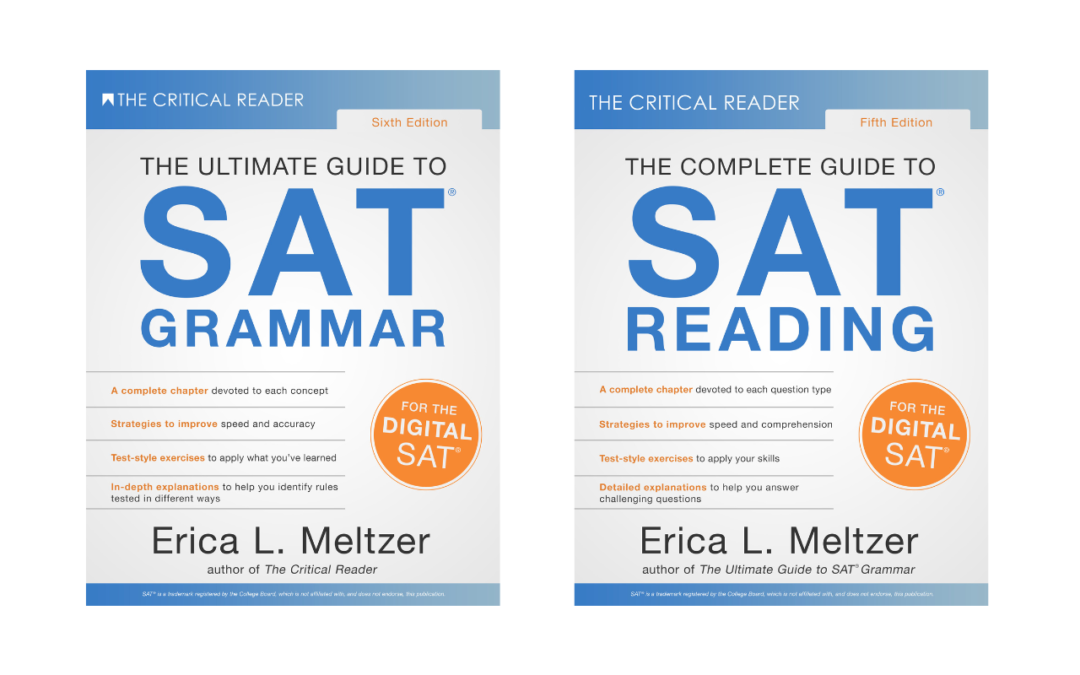
by Erica L. Meltzer | Oct 7, 2023 | The Digital SAT, Vocabulary
Larry Krieger and I have been hard at work on our digital-SAT edition of SAT Vocabulary: A New Approach, with release tentatively planned for December. Unfortunately, I’ve been pretty much out of commission with a bad cold the last couple of weeks, but Larry has come to the rescue with a fabulous post featuring the saga of Taylor and Travis… along with some top words for the new test. Even if you’re not a Swiftie, it’s good reading. Here goes:
Students often complain that learning vocabulary words is tedious and boring. Not in our book! We have written a series of special chapters that use popular movies like Barbie, Oppenheimer, and Avengers: End Game to illustrate the words on our list. The following chapter on the possible romance between Taylor Swift and Travis Kelce illustrates our unique method of helping your remember difficult DSAT vocabulary words.
1. Taylor Swift ECLIPSES the game
ECLIPSE – to overshadow
On Sunday September 24th the defending Super Bowl champion Kansas City Chiefs played the Chicago Bears before a capacity crowd of 76,000 fans at Arrowhead Stadium. Led by their Superbowl MVP quarterback Patrick Mahomes and their all-pro tight end Travis Kelce, the Chiefs quickly took command of the game. Within a short time the crowd’s attention switched to an unexpected global celebrity – Taylor Swift! Taylor’s presence in a luxury suite seated beside Travis Kelce’s mom quickly ECLIPSED interest in the game. Fueled by Swift’s 12-17 and 18-49 year-old fans, television ratings soared as an estimated 24 million people watched the game.
2. Swifties begin to make INFERENCES
INFERENCE – a deduction or conclusion based upon evidence and reasoning
Known as Swifties, Taylor’s fans quickly began to make INFERENCES about her unexpected appearance at an NFL game. Taylor is well-known for leaving her fans carefully planted clues called “Easter eggs.” Afterall in her song “Blank Space”, Taylor declared, “Love’s a game, wanna play?” Many INFERRED that this was Taylor’s way of signaling the beginning of a romantic relationship with Travis.
3. Taylor fails to RECIPROCATE
RECIPROCATE – a mutual or equivalent exchange
The relationship between Taylor and Travis did not get off to a promising start. Travis attended Taylor’s sold-out concert at Arrowhead Stadium back in early July. He tried to send Taylor a friendship bracelet with his number. But Taylor did not RECIPROCATE. Ouch!
4. Travis is RESILIENT and refuses to give up
RESILIENT – able to bounce back from adversity; quickly recover
Taylor’s failure to respond to his invitation did not deter Travis. Although he admitted to feeling “a little butthurt,” Travis was RESILENT and refused to give up. He used his popular podcast to send Taylor this message: “I’ve seen you rock the stage at Arrowhead Stadium. You might have to come see me rock the stage in Arrowhead and see which one’s a little more lit>”
5. Would Travis’s AUDACIOUS invitation work?
AUDACIOUS – bold and daring
Travis’s AUDACIOUS but risky public invitation worked. Taylor attended the game and then left the stadium with Travis in his prized 1970 Chevolet Chevelle SS convertible. Wow – that really is AUDACIOUS. But Travis wasn’t finished. He drove Taylor to a private dinner party at a well-known and fully reserved Kansas City restaurant. Taylor reportedly had a great time dancing with Travis and meeting all-world Kansas City quarterback Patrick Mahomes.
6. An INDELIBLE day
INDELIBLE – memorable; cannot be forgotten
Travis clearly seized the moment and tasted it. The game and the evening dinner party left him with INDELIBLE memories. Travis later reported that Taylor “looked amazing” and that “everybody in the suite had nothing but great things to say about her…It’s definitely a game I’ll remember, that’s for damn sure.”
7. The game was PERIPHERAL
PERIPHERAL – of secondary importance; not central
The Kansas City Chiefs narrowly defeated the New York Jets in an exciting Sunday Night Football game. But the game was a PERIPHERAL sideshow to the night’s real story. All eyes were focused on a private suite containing Taylor Swift and her entourage of Hollywood pals that included Deadpool 3 actors Ryan Reynolds and Hugh Jackson and Game of Thrones star Sophie Turner. The NBC camera crews obliged Taylor’s legion of Swifties by cutting from the game to her box 17 times.
8. Taylor is an economic CATALYST
CATALYST – any stimulus that causes significant change or action
Over 27 million viewers tuned in to watch Taylor Swift and her entourage of celebrities watch the Sunday Night Football game. Taylor’s economic impact is much greater than prompting her legion of Swifties to watch a football game. Taylor is a significant economic CATALYST. Her Eras Tour is on track to become the biggest and most profitable in concert history. When Taylor
comes to town her fans go on a spending spree by filling hotels, packing restaurants, and purchasing everything Taylor-themed bracelets to expensive cloths.
9. This is INTRIGUING!
INTRIGUING – arousing great interest and curiosity
So what will happen next? Sports fans and Swifties are INTRIGUED! Is this the beginning of a new romantic relationship? Will Travis + Taylor = Traylor? Or will Travis end up in one of Taylor’s songs? But one of Taylor’s most popular songs does offer a ray of hope: “I’ve got a blank space baby and I’ll write your name.” Could Travis be the one? Stay tuned!!
10. Questions and CONJECTURES
CONJECTURE – an opinion or conclusion formed on the basis of incomplete evidence; speculation
The apparent romantic link between Taylor and Travis is like an unexpected meteor strike that has ignited a social media firestorm. Commentators on podcasts, TikTok, and Instagram are all spreading rumors, providing breathless headlines, and asking endless questions. But their revelations are all CONJECTURES. The reality is that no one knows what Taylor and Travis will do next. But one thing is certain – Erica and I will keep you posted on all the breaking news!!!

by Erica L. Meltzer | Sep 27, 2023 | Blog, Grammar (SAT & ACT)
In all my years of tutoring and writing about grammar, this particular point of confusion has never come up… that is, until a couple of days ago, when I clicked through a YouTube SAT-grammar video sent by a colleague and realized, after a brief period of confusion, that the tutor confidently expounding on conjunctions was actually talking about contractions. I was not exactly shocked—I mean, it is YouTube—but still, it was pretty painful to watch.
Operating under the assumption that if one person is confused about a given point—particularly someone trying to explain it to literally thousands of people—then many other people are probably confused as well, I plugged “conjunctions vs. contractions” into Google to see what the depths of the Internet would reveal. Although the phrase popped up immediately as a search term, I was, to my considerable surprise, unable to find a single explanation that both addressed the issue directly and was written in coherent, grammatical English. I felt obligated to remedy the situation, hence this post. (more…)

by Erica L. Meltzer | Sep 11, 2023 | Books
I am very happy to announce some new book releases.
First, the e-book editions of The Ultimate Guide to SAT Grammar, 6th Edition, and The Critical Reader, 5th Edition, are now available on Amazon Kindle. (more…)
by Erica L. Meltzer | Sep 1, 2023 | Books
I am very happy to announce two additional forthcoming Critical Reader prep books for the digital SAT.
The first is a test book to accompany the main Reading and Writing guides. It features three full-length Reading & Writing tests in dSAT format (two modules per exam, each with 27 questions) and includes detailed explanations for all questions. It should be available from both Amazon and The Critical Reader within the next two weeks. (Please note that this book replaces The Ultimate Guide to SAT Grammar Workbook; because the number of Writing questions is considerably reduced on the digital test, it did not make sense to have a book of practice tests devoted solely to that portion of the exam.)
The second guide is a vocabulary book, on which I am very happy to be collaborating again with Larry Krieger. The book features approximately 200 challenging must-know words for both sentence completions and transitions, along with numerous entertaining examples drawn primarily from contemporary pop culture (think plenty of Barbie, with some Oppenheimer and The Avengers thrown in, plus an eclectic* mix of other references).
I really have to hand it to Larry: his knowledge of pop culture positively puts mine to shame, AND he actually managed to distill the Avengers plot down into a few hundred easy-to-follow words. Most impressive!
We’re doing our best to get a beta version of the book out sometime this month so that it can be used for PSAT preparation, with a final version to follow in the late winter or early spring. Stay tuned for more details.
*Varied, diverse, heterogeneous; note that this has traditionally been a favorite SAT word, and all signs suggest that the College Board is once again relying on the top ETS list. So much for that whole “no more ‘obscure’ (ha!) words” thing.

by Erica L. Meltzer | Aug 17, 2023 | Blog
In my previous post, I discussed the recently published paper by superstar Harvard economist Raj Chetty, along with colleagues from Brown, confirming what I suspect most people involved in selective college admissions could intuitively report—namely, that the top 1%, and really the top .1%, enjoy a massive advantage in the college admissions process, largely as a result of a non-academic factors.
I’ve read the full paper, and although the statistical formulas used to calculate the effects are well over my head, the conclusions Chetty et al. draw are quite clear. (A detailed summary is also available.) Some of the main takeaways are as follows. (more…)

by Erica L. Meltzer | Aug 5, 2023 | College Admissions
I’m going to begin this post with dSAT-style text completion.
In a 2023 paper, the Harvard economist Raj Chetty, along with colleagues from Brown University, showed that affluent students enjoy a significant advantage in the elite college admissions process: for applicants who received high academic ratings, comprising a rigorous course load and test scores in the 99th percentile (1510+ SAT/34+ ACT), those with family incomes in the top 1% were admitted to Ivy-plus institutions at a 43% higher rate than middle-class applicants, and applicants in the top .1% were admitted at a 250%* higher rate. The researchers found that high-achieving affluent and non-affluent students applied to Ivy-plus schools at relatively similar rates and received comparable academic assessments; however, wealthy students received significantly higher ratings for “personal qualities,” legacy status, and athletics. Based on these findings, Ivy-plus schools that want to improve the economic diversity of their student bodies should ________
(A) place less weight on non-academic factors that disproportionately favor wealthy applicants.
(B) recruit more heavily at high schools that enroll predominantly low- and middle-income applicants.
(C) give greater consideration to personal qualities such as empathy and curiosity.
(D) adopt policies allowing applicants to choose whether to submit SAT or ACT scores.
If you approached this question from the standpoint of reason and logic, you probably picked (A): if, all things being equal academically, the emphasis on “character,” along with legacy and athletic-recruitment status, disproportionately favors wealthy applicants, then placing less emphasis on those factors would presumably result in a more even distribution of students from across the economic spectrum.
However, as you may have guessed from the title of this post, this is a trick question.
If you’re an elite private college (other than MIT), the answer is of course (D).
Why?
Because the response to basically any form of inequity in the admission process is always to remove standardized testing requirements—even when the data directly suggest that doing so would be counterproductive. Indeed, highly ranked public flagships, which rely more on objective metrics, admit students much more evenly across the economic spectrum.
To be clear, the issue is not a dearth of applicants. Academically qualified middle- and lower-income students are already applying to Ivy-plus institutions in large numbers: slightly more than 11,000 per graduating high school cohort, according to Chetty et. al., with another 13,000 likely to attain high academic ratings if they applied. If those students are not being admitted under the current system because of “soft” factors, not because of their test scores, then there is absolutely no reason to think that academically weaker students—as candidates who do not submit SAT or ACT scores tend to be—would be more likely to gain admission (particularly since Affirmative Action has been dismantled).
So, yes, although there is a direct correlation between family income and test scores, although there are gaping disparities in the type of test preparation applicants have access to, the SAT and ACT are still doing more or less what they were introduced to do: provide talented students from outside the traditional prep-school circuit a way to demonstrate that they could compete academically with their more advantaged peers.
In fact, given the disparities in preparation, Chetty and his colleagues mention that standardized tests probably have even more predictive value for middle- and lower-class applicants than they are given credit for.
I have more thoughts about the paper, but I’ll save them for my next post.

by Erica L. Meltzer | Jul 16, 2023 | Blog, College Admissions, Test Optional
Now that the Supreme Court has issued its expected ruling dismantling Affirmative Action, it is reasonable to assume that widescale test-optional admissions are here to stay. While applicants are still free to discuss their ethnic backgrounds in their essays, and colleges may consider that information as part of the holistic review process, the ruling issues a clear warning to schools not to attempt to use such information in an attempt to circumvent either the letter or the spirit of the ruling.
Although the new landscape is murky, and colleges are understandably hesitant to undertake an action that might result in additional court cases, it is also clear that they will take any legally permissible steps necessary to enroll URM applicants. As Bates professor Tyler Harper pointed out in a New York Times piece responding to the ruling, this is likely to result in an admissions process that is even more subjective, opaque, and open to “racial gaming” than it is at present—in the absence of test scores, accusations of unfairly (dis)advantaging certain categories of applicants become much that more difficult to prove in court, and, there will undoubtedly continue to be much wailing and gnashing of teeth about How the Woke Mob Is Destroying the Great American University.
However, there is rhetoric and virtue-signaling, and then there is a more complex reality. In fact, the test-optional movement cuts both ways. On a small scale, it will undoubtedly result in the admission of some underrepresented minority students who would not have gained acceptance to particular institutions otherwise. On a very broad scale, in contrast, those effects are likely to be more muted. From universities’ standpoint, there are benefits to dropping standardized testing requirements that are entirely unrelated to promoting equity, and that are likely to benefit the most advantaged applicants.
(more…)

by Erica L. Meltzer | May 24, 2023 | The Digital SAT
At this point, I’ve spent many months picking apart released dSAT questions and attempting to use their logic and patterns to construct hundreds of my own. I realize that I haven’t offered much in the way of opinions about the digital exam, but that’s mostly because I’ve been spending so much of my time over the last six-plus months trying to get the new editions of my SAT books finished. I assure you that I have been thinking very, very hard about the alterations.
So that said, are six key changes—both positive and negative—that I think are particularly deserving of attention, and I’d like to discuss them here.
1) Short-Passage, One-Question Format
Without a doubt, this changed makes the exam more streamlined and is ideally suited to the online format. Longer passages would require test-takers to continually scroll up and down, making the process of answering questions somewhat awkward and increasing the chances important information will be overlooked.
This shift also brings the SAT closer to exams such as the GRE and GMAT, which have been offered electronically for many years and feature primarily short passages.
As much as I appreciate the practical aspects of this decision, however, I still find it worrisome because it so clearly panders to ever-decreasing expectations about the amount that students in both high school and college should be expected/able to read. Anecdotally speaking, several colleagues who teach at the secondary and post-secondary levels have told me that they can now only assign a fraction of the reading they regularly assigned even five or ten years ago, and one (non-tenured) friend who teaches at an extremely selective university was recently reduced to bargaining with her students about the amount of reading they would tolerate—not for one assignment, but for the entire semester.
This really does not bode well.
In theory, at least, dealing with complex arguments in writing is one of the main purposes of college, and most serious ideas cannot be boiled down into a paragraph. Call me old-fashioned, but from my perspective a student who seriously cannot handle even 500-750 words of text is not ready for a university-level education. (more…)
by Erica L. Meltzer | May 8, 2023 | Books, The Digital SAT
I am happy to report that Amazon/KDP has approved the file for the final version of The Ultimate Guide to SAT Grammar, 6th Edition, making both the grammar and reading books available for through Amazon and The Critical Reader.
At this time, we do not yet have copies of the new editions in our warehouse, so books must be sent directly from the printer. As a result, orders may take longer to arrive than would normally be the case. If you need the books urgently, please order directly from Amazon.
In addition, please note that if you are located outside of the United States and wish to purchase the books on Amazon, you must order through the corresponding Amazon page in your country of residence.
If you have a question regarding the new editions, please contact us directly.
by Erica L. Meltzer | Apr 28, 2023 | Blog
I am happy to announce that the final version of The Critical Reader, 5th Edition, for the digital SAT, is now available on Amazon.
Approval for The Ultimate Guide to SAT Grammar is still pending and, based on recent experience, may take an additional few weeks to be granted.
Although it is impossible to know for sure, this is likely due to formatting issues in the grammar book that causes the file to require manual inspection from Amazon in order to be approved. In the past, this has not caused significant problems; however, Amazon has made major staffing cuts in recent months, and it seems reasonable to assume that the increased turnaround times are among the results.
If you would like to pre-order the book through The Critical Reader, please contact us, and we will have you sent a copy as soon as the book is available.
We apologize for the delay.
by Erica L. Meltzer | Apr 15, 2023 | The Digital SAT
I am happy to announce that the new editions of my SAT grammar book (6th ed.) and reading book (5th ed.) are undergoing final checks and are almost ready to be released.
Now for the less-good news: Because Amazon’s file-approval process has become unpredictable, there is unfortunately no way to set a firm date when the books will be available.
In the best case scenario, the books could be ready for purchase sometime this week (3/16/23); however, it is also possible that the approval process for one or both of the books will take up to several weeks, as occurred during a previous round of submissions.
I will post an announcement as soon as the books can be ordered, and in the meantime, I appreciate everyone’s continued patience.

by Erica L. Meltzer | Mar 3, 2023 | The Digital SAT
Of all the pieces of advice I have for the Writing portion of the digital SAT, this is probably my #1, and it’s particularly important because it involves a new question type.
Whereas the paper-based post-2016 exam featured ACT knock-off “rhetoric” questions asking test-takers whether a given piece of information should be revised, added to, or deleted from a passage, the digital version has scrapped these items and replaced them with a much more complicated-looking type of question involving sets of bullet points representing notes that a “student” has taken about a topic.
Based on the material released by the College Board, it appears that this will be a very common question type: second in frequency only to questions involving transitional words and phrases, and potentially appearing as many as four or five times in a given module.
After working through a few of these questions, bouncing back and forth between the bullet-pointed information and the answer choices, occasionally losing track of exactly what I was supposed to be looking for and getting lost in a thicket of information, I had a classic “duh” moment: the questions themselves told me what type of information the correct answer had to contain—it was unnecessary to even look at the bullet points at all. (more…)

by Erica L. Meltzer | Feb 12, 2023 | Grammar (SAT & ACT), The Digital SAT
Note: The strategies covered in this post can also be applied to the paper-based. Just cover up the transition that is already in the passage; otherwise, the steps are basically the same.
On many versions of the digital SAT, you can expect to encounter about five questions per module testing transitional words and phrases, making this the most common question type on the Writing portion of the test. To ensure you earn what are usually fairly easy points, it is crucial to have an understanding of how to work through these questions before you walk into the exam.
The most important thing is to avoid getting caught up in the details—questions are designed not so much to test particular words as they are to test three main categories of relationships, namely continuation, cause-and-effect, and contrast.
As a result, the fact that therefore might appear in one set of answers, whereas a second might contain thus and a third hence is effectively irrelevant. These words serve the same rhetorical purpose—to indicate a result in a cause-and-effect relationship—and it is the relationship that is really being tested. The words themselves are secondary.
1) Read the question but not the answer choices
A quick glance at the question will tell you that it is testing transitions.
If you happen to notice that the answers consist of, say, However, Moreover, Specifically, and Therefore, that’s obviously a sign as well, but initially you should not worry about the specific words involved. In fact, you should do your best to ignore them because they are more likely to confuse you than to help. (more…)
by Erica L. Meltzer | Feb 8, 2023 | Blog
We are very happy that the SAT Reading and Writing guides for the new digital SAT have received such an enthusiastic response, and we understand that the March exam is coming up very soon; however, if you have ordered the books, or if you plan to order them, we ask you to keep a few things in mind regarding shipping and tracking.
- As these are preliminary versions that were just released, we do not yet have a stock at our US-based warehouse or at our Korean distributor.
- All books are currently being printed and shipped via Amazon/KDP. It can take up to 10 days for the books to print, and shipping times will vary based on location and shipping service. Unfortunately, Amazon printing times can vary dramatically, and there was no way to predict this delay in advance.
- We are unable to ship the books faster at this time.
- We will send you any tracking information we receive from Amazon as soon as it is updated.
- If you live in certain countries, including India, you will be required to send a photo of your ID as per customs regulations. If we do not receive your ID within 48 hours of it being requested, we unfortunately will not be able to process your order (it will be canceled and refunded to original form of payment).
(more…)

by Erica L. Meltzer | Jan 29, 2023 | Books, The Digital SAT
I am happy to announce that the preliminary versions of The Ultimate Guide to SAT Grammar, Sixth Edition, and The Critical Reader, Fifth Edition are now available for international students preparing for the new digital SAT in March, as well as tutors working with International students and any U.S. students taking the digital school day SAT this spring.
If you live outside the United States and unable to order from Amazon locally, you can order directly through The Critical Reader. Students located in South Korea will be able to purchase books through our Korean distributor, JMK Education. As of 1/29/23, we are in the process of arranging to have an order shipped to them.
Both books have retained their core components but have been fully reworked to reflect the content and format of the digital SAT. While it is possible that there will eventually be some minor reshuffling of content (particularly in the grammar book, since it’s not entirely clear whether certain concepts will tested on the digital exam), I hesitate to call them beta versions because the bulk of the material is effectively final. The only major changes planned at this point are the additional of end-of-chapter practice questions/explanations in the reading book, and full explanations for end-of-chapter exercises in the grammar book.
In order to make the books available on the various international Amazon sites, there was no choice to publish to the main U.S. site as well—so yes, the books are technically available there now. However, I am aiming to release the expanded versions of both books by April, so you may want to wait to purchase them if you are planning to take the digital exam in June or later and do not need to start studying urgently.
Ensuring that the new editions matched the level of quality of the previous editions while getting them to publication in only a few months has been an enormously challenging process, and again, I very much appreciate everyone’s patience while I worked out all the unforeseen (but inevitable) last-minute kinks.
Note: comments on this post have been closed. If you have a question regarding book orders, please send us a message via the contact form, or email thecriticalreader1@gmail.com.

by Erica L. Meltzer | Jan 3, 2023 | Grammar (SAT & ACT), The Digital SAT
For those of you taking the digital SAT in March, I’ve made a new version of my free Writing cheat sheet available for download.
Although the core content of the digital Writing test is similar to that of the current paper-based version, there are a few key differences—most notably, the extremely high emphasis on transitional words and phrases; the introduction of student “notes” questions; and the elimination of diction/register questions—and the sheet has been updated to reflect these changes.
As I mentioned, it may take me a few more weeks to get the reading and writing books on international Amazon, but in the meantime, I’ll try to put up a few posts on the most important features of the digital exam.
by Erica L. Meltzer | Dec 1, 2022 | Blog, Books, The Digital SAT
I apologize for the delay and appreciate everyone’s patience. This is the fastest I have ever had to revise such a huge quantity of material (there was no way for me to begin serious work on the updates until the College Board released the first full digital practice test at the beginning of October). And because I am an actual person who sometimes has to deal with life beyond test preparation, I needed to take a break for a couple of weeks during the holidays.
Happy New Year, congratulations to everyone who got done with testing or into college, and wishing you a good 2023.
-EM
Update 12/1: As of the beginning of December 2022, I have completed drafts of new editions of The Ultimate Guide to SAT Grammar (6th edition) and The Critical Reader (5th edition).
While the books retain many key elements, they have been substantially overhauled and are now fully aligned with the digital exam—based on the four practice tests released by the College Board—and will be available for purchase for international test-takers in some capacity by late December or January 2023.
Both books will be in something very close to their final form; the only major difference will be in the number of exercises (particularly in certain chapters of the Reading book) and the presence of detailed explanations for every question in the end-of-chapter exercises, which are likely to be too time-consuming to produce in full for both books by the end of the year.
Also, full disclosure: there will only be time for the books to undergo one round of proofing, so there may be a few lingering typos (this is the unfortunate price for getting them out so quickly).
Otherwise, as in previous editions, each guide contains a full chapter devoted to each question type; numerous worked, in-chapter examples with step-by-step explanations; and numerous strategies for simplifying questions and zeroing in on key information.
I’ve worked incredibly hard on the revisions over the last couple of months, and I feel confident that they will provide thorough preparation for students taking the digital test in March.
I expect finalized versions that have detailed explanations for the end-of-chapter exercises and that have undergone multiple rounds of proofing to be available sometime in the spring of 2023. Current sophomores who are preparing for the digital PSAT next fall should have plenty of time to work with them over the summer.
I appreciate everyone’s patience and will be posting previews of both books as soon as possible.

by Erica L. Meltzer | Sep 30, 2022 | Blog, The Digital SAT
I apologize for not having posted an update sooner, but I’v had an unusual number of projects to juggle over the last several months and have only been able to begin serious work on the updated SAT books in the last few weeks. I understand, however, that everyone is very anxious for information regarding the new exam as well as eager to work out a prep plan, and that the earlier international rollout of the digital test has made things challenging for current eleventh graders living outside the U.S. So I’ll do my best here to outline my own timeline regarding book releases here and to provide some interim options for prep materials.
First, the basics. Yes, I will revising my SAT reading and grammar books to reflect the content and structure of the digital test. They updated versions will be completely new editions: 5th edition of The Critical Reader, 6th edition of The Ultimate Guide to SAT Grammar.
The essential content and structure of the books will not change, although they will likely be somewhat slimmed down to reflect the shorter, more focused digital reading and writing sections (two sections, 27 questions each, with performance on the first section determining the difficulty of the questions seen on the second). (more…)











